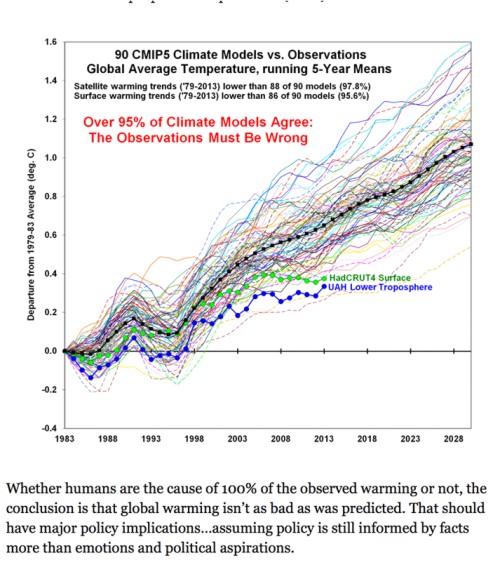Many articles in the Herald over the past few years have emphasised the dangers of man-made global warming (aka “climate change”) and warned us that extreme measures are needed to save us from this imminent climatic disaster. Almost without exception, the authors of these articles have assumed that man-made carbon dioxide causes dangerous global warming, rapid sea level rise and more floods, droughts, cyclones and so on.
But what does the evidence tell us?
Regarding world temperatures, historical records from ice cores tell us that it was warmer during the Mediaeval Warm Period, the Roman Warm Period and the Bronze Age. The Mediaeval Warm Period was experienced all over the world including Australia and New Zealand.
The oldest set of recorded temperatures comes from central England and started in the mid 1600s. They show a temperature rise of a little more than 1°C – which is not surprising as the record started in the middle of the Little Ice Age. Since 1900 – which was fairly cold – most temperature records show that the world warmed quite rapidly up until the 1940s, then the temperature declined until 1975 when it rose again at the 1930s rate until about 2000.
Since the 1970s, satellite measured temperatures which, NASA says, are the most accurate, have been available and, if the two El Nino events are ignored, show no statistically significant temperature rise for the last 18 years. By contrast, the computer-based climate models predicted temperatures about 0.5° higher than they really are and the IPCC has admitted that 97% of its temperature predictions were much higher than actual temperatures. Should we believe the evidence or the models?
What will happen next? The climate models predict rapidly increasing temperatures but people who have studied past temperature cycles, sunspot cycles and the current dearth of sunspots predict that a substantial worldwide drop in temperature is highly probable. Who is right? Only time will tell – and quite soon. The present El Nino temperature peak will be followed by an equally dramatic drop in temperature as La Nina sets in. But no one really knows what will happen after that.
Sea level rise is reasonably well documented for the last hundred plus years from tide gauge records that show that it has been at a fairly steady rate in the region of 0.14 and 0.17 m per century. This is not unexpected given that we are still coming out of the Little Ice Age. Since the 1970s, sea levels have been measured by satellites that show a rate of rise of 0.32 m per century. No one is quite sure why the disparity exists. Some people believe it is because they are biased by mid-ocean sea level rise which does not affect the situation along shorelines. Neither record shows any sign of a recent and rapid increase in sea levels.
Sadly, this does not stop academics who specialise in computer models of the climate advising the Royal Society of New Zealand that sea levels are likely to rise rapidly and reach between 0.3 m and 1 m by 2100 – more than predicted by the U.N.Intergovernmental Panel on Climate Change (IPCC). Scientists with practical experience of sea level changes around New Zealand point out that the coastline is subsiding in some places and rising in others. The Royal Society advisers have ignored these movements and the slow rise in New Zealand sea levels over the last 100 years. Similar extreme predictions have been adopted by the Ministry of the Environment and are now being used by Councils to devalue coastal land and limit development near the sea. They have even predicted sea level rise in places where the land is rising from the sea!
A recent article in the Herald stated that sea levels in some Solomon Islands were rising rapidly because of global warming. It also said that the sea level at Tuvalu was rising and forcing people to flee. The reality is quite different: it is well-known that the islands in the Solomons are steadily sinking beneath the sea and the accurate tide gauges installed by the Australian government at Tuvalu in the 1990s show that there has been no significant increase in sea level.
A study by a New Zealand academic showed that the land area of Pacific atolls is increasing. If it didn’t, then all the atolls in the ocean would have been drowned when the sea level rose at 3 m per century coming out of the last ice age.
Regarding floods, droughts, cyclones and the like, there is no convincing evidence that these are increasing. The IPCC agrees. A recent scientific paper analysed the past history of these events and concluded that they were less frequent now than during most of the past 1000 years.
So, as is so often the case, the perception and reality are vastly different. In New Zealand this is not helped by a mainstream media that seldom publishes anything that examines the evidence and propounds a different view. Yet there is no doubt that the science is NOT settled and debate is needed.
References
These are some of the many references that confirm what I have said above.
World temperatures:

http://www.longrangeweather.com/global_temperatures.htm
http://www.drroyspencer.com/global-warming-background-articles/2000-years-of-global-temperatures
Modelled temperatures
http://www.drroyspencer.com/2014/02/95-of-climate-models-agree-the-observations-must-be-wrong/
Sea Level Rise
1.48 mm/yr since the early 1900s –
http://www.sealevel.info/NOAA_AllStationsLinearSeaLevelTrends_2015-08_50yr_less_high30_and_low40.htm
Australian sea level rise since early 1990s
http://www.bom.gov.au/ntc/IDO60201/IDO60201.201603.pdf





